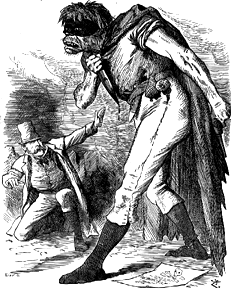

 he subject of Ireland in Punch cartoons perhaps best illustrates the significance of caricature in regard to public opinion and prejudice. In the 1880's, agitation over the Irish Land Question-- championed by the "uncrowned king of Ireland," Irish National Party Leader
Charles Parnell -- led to increased violence against landowners. This 1882 cartoon chooses as its subject the brutal and shocking assassinations of two British political figures, Lord Frederick Cavendish and Mr. Thomas Burke, in Phoenix Park, Dublin. While the murders were immediately credited to a small number of militant Irish separatists unrelated to the Irish Parliamentary Party, the incident exacerbated anti-Irish racial antagonisms and crushed the Home Rule bill instantaneously. Splitting the Liberal Party in two, Liberal Unionists asserted that passage of Home Rule legislature would only demonstrate the legitimacy of Irish terrorism. Fearing retribution at the hands of an emotional and brutal race of subhumans, Gladstone's, subsequent Home Rule bills were defeated. The cartoon's accompanying quotation from Parnell states his lament that his own actions in support of the Irish Land Question spawned a rebellious movement now grown beyond the "control of its creator." Like Dr. Frankenstein, Parnell has created a monster-- Irish terrorism in the form of Captain Moonlight's nocturnal agrarian atrocities. The cartoonist portrays Ireland as a Nietszchean abomination, a sudden and uncertain evil that threatens the lifeblood of Great Britain. Interestingly enough, the monstrous physical attributes depicted are essentially just typical Irish caricature features enlarged. The fact that Tenniel, does not continue to exaggerate the subject's physiognomy implies that criminal animalities exist within the average Irishman, not just surfacing in a few "Frankensteins." One may thus conclude that the vision of the Irishman as subhuman or monster is part of a British prejudicial continuum.
he subject of Ireland in Punch cartoons perhaps best illustrates the significance of caricature in regard to public opinion and prejudice. In the 1880's, agitation over the Irish Land Question-- championed by the "uncrowned king of Ireland," Irish National Party Leader
Charles Parnell -- led to increased violence against landowners. This 1882 cartoon chooses as its subject the brutal and shocking assassinations of two British political figures, Lord Frederick Cavendish and Mr. Thomas Burke, in Phoenix Park, Dublin. While the murders were immediately credited to a small number of militant Irish separatists unrelated to the Irish Parliamentary Party, the incident exacerbated anti-Irish racial antagonisms and crushed the Home Rule bill instantaneously. Splitting the Liberal Party in two, Liberal Unionists asserted that passage of Home Rule legislature would only demonstrate the legitimacy of Irish terrorism. Fearing retribution at the hands of an emotional and brutal race of subhumans, Gladstone's, subsequent Home Rule bills were defeated. The cartoon's accompanying quotation from Parnell states his lament that his own actions in support of the Irish Land Question spawned a rebellious movement now grown beyond the "control of its creator." Like Dr. Frankenstein, Parnell has created a monster-- Irish terrorism in the form of Captain Moonlight's nocturnal agrarian atrocities. The cartoonist portrays Ireland as a Nietszchean abomination, a sudden and uncertain evil that threatens the lifeblood of Great Britain. Interestingly enough, the monstrous physical attributes depicted are essentially just typical Irish caricature features enlarged. The fact that Tenniel, does not continue to exaggerate the subject's physiognomy implies that criminal animalities exist within the average Irishman, not just surfacing in a few "Frankensteins." One may thus conclude that the vision of the Irishman as subhuman or monster is part of a British prejudicial continuum.
[Victorian initial "T" by Harlan Wallach ©copyright 1994.]